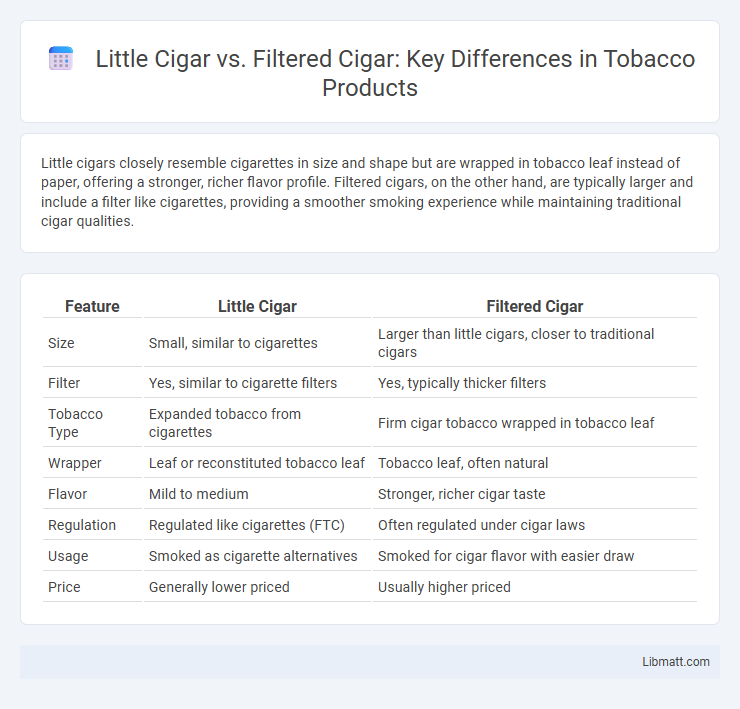Little cigars closely resemble cigarettes in size and shape but are wrapped in tobacco leaf instead of paper, offering a stronger, richer flavor profile. Filtered cigars, on the other hand, are typically larger and include a filter like cigarettes, providing a smoother smoking experience while maintaining traditional cigar qualities.
Table of Comparison
| Feature | Little Cigar | Filtered Cigar |
|---|---|---|
| Size | Small, similar to cigarettes | Larger than little cigars, closer to traditional cigars |
| Filter | Yes, similar to cigarette filters | Yes, typically thicker filters |
| Tobacco Type | Expanded tobacco from cigarettes | Firm cigar tobacco wrapped in tobacco leaf |
| Wrapper | Leaf or reconstituted tobacco leaf | Tobacco leaf, often natural |
| Flavor | Mild to medium | Stronger, richer cigar taste |
| Regulation | Regulated like cigarettes (FTC) | Often regulated under cigar laws |
| Usage | Smoked as cigarette alternatives | Smoked for cigar flavor with easier draw |
| Price | Generally lower priced | Usually higher priced |
Understanding the Basics: What Are Little Cigars and Filtered Cigars?
Little cigars are small, tobacco-wrapped products resembling cigarettes in size and shape but generally contain more tobacco and are sold in packs of 20. Filtered cigars, also known as cigarillos or mini cigars, are slightly larger than little cigars, often contain natural tobacco wrappers, and feature filters similar to cigarettes. Both types offer different smoking experiences, with little cigars typically delivering a milder flavor and filtered cigars providing a richer, more robust taste.
Size and Shape: Comparing Little Cigars vs Filtered Cigars
Little cigars typically measure between 70 to 90 mm in length with a diameter similar to cigarettes, often featuring a straight cylindrical shape. Filtered cigars are generally larger, ranging from 90 to 120 mm or more, with a thicker ring gauge and a distinct tapered or rounded shape. The size difference influences smoking duration and flavor concentration, with filtered cigars offering a longer, fuller smoke due to their size and shape.
Tobacco Content and Blending Differences
Little cigars typically contain a blend of air-cured tobaccos similar to cigarettes, offering a milder flavor and lower tobacco content compared to filtered cigars. Filtered cigars, on the other hand, use a denser, often dark-fired tobacco blend, resulting in a fuller taste and higher tobacco content. Your choice between them depends on whether you prefer a lighter, cigarette-like experience or a richer, more robust cigar flavor.
Filter Design: Key Distinctions Between Little and Filtered Cigars
Little cigars feature a tighter, often shorter filter design with a densely packed tobacco filler, providing a smoking experience closer to cigarettes. Filtered cigars, in contrast, incorporate longer, thicker filters made of multifaceted cellulose acetate that better reduce tar and nicotine levels. This key distinction influences draw resistance, flavor intensity, and overall combustion characteristics, differentiating the smoking profiles of little and filtered cigars.
Wrapping Material: Paper vs Tobacco Leaf
Little cigars use paper as the primary wrapping material, closely resembling traditional cigarettes in appearance and texture, which allows for a smoother and more consistent burn. Filtered cigars, on the other hand, are wrapped in tobacco leaf, providing a richer flavor profile and a more robust smoking experience due to the natural leaf's porous texture. The choice of wrapping material significantly impacts the smoking characteristics, taste, and overall quality between little cigars and filtered cigars.
Smoking Experience: Flavor and Aroma Compared
Little cigars offer a smoking experience closer to traditional cigarettes with a mild flavor and subtle aroma, making them appealing for those seeking a smoother, less intense smoke. Filtered cigars, on the other hand, deliver a richer, fuller-bodied flavor and stronger aroma, often made from higher-quality tobacco blends that provide a more robust and satisfying experience. The presence of a filter in both enhances the appeal, but filtered cigars generally provide a more complex sensory profile compared to the lighter, more straightforward notes found in little cigars.
Packaging and Presentation Variations
Little cigars typically come in packs resembling cigarette packaging, such as 20-count boxes or plastic pouches, making them convenient and discreet for your on-the-go use. Filtered cigars often feature sturdier, more elaborate boxes or tins that emphasize a premium presentation and better preservation of flavor and aroma. These packaging distinctions reflect branding strategies targeted at different consumer preferences and usage occasions.
Legal Classifications and Tax Differences
Little cigars and filtered cigars differ significantly in legal classifications and tax treatment; little cigars are often regulated like cigarettes and subject to similar excise taxes, while filtered cigars may fall under less stringent cigar-specific regulations with potentially lower tax rates. The definition hinges on size, weight, and tobacco content, influencing how federal and state laws impose restrictions and taxes, affecting pricing and availability. Understanding these distinctions helps you navigate their market differences and legal implications more effectively.
Health Considerations: Risks and Misconceptions
Little cigars and filtered cigars both pose significant health risks similar to cigarettes, including exposure to harmful toxins and increased risk of lung and heart diseases. Many consumers mistakenly believe that filtered cigars are safer due to their resemblance to cigarettes, but the presence of nicotine, tar, and carcinogens remains substantial in both types. Your health can be compromised by regular use of either, so understanding these misconceptions is critical for informed decisions about tobacco consumption.
Consumer Preference: Which One Should You Choose?
Consumer preference between little cigars and filtered cigars hinges on flavor intensity and smoking experience. Little cigars tend to offer a stronger, more robust taste with a traditional tobacco leaf wrapper, appealing to those seeking a richer aroma. Filtered cigars, featuring a milder flavor and cigarette-like filters, attract smokers who prefer smoother draws and reduced harshness.
“Little Cigar” vs “Filtered Cigar” Infographic

 libmatt.com
libmatt.com